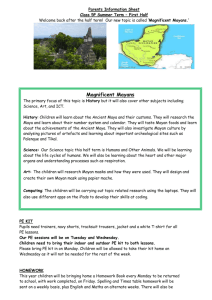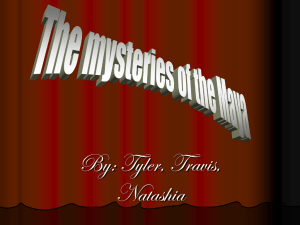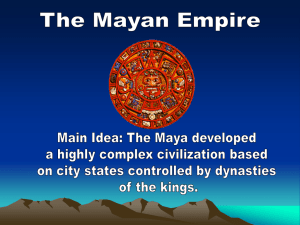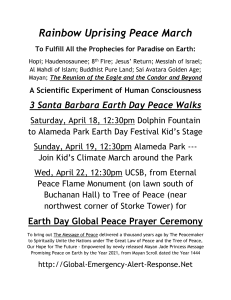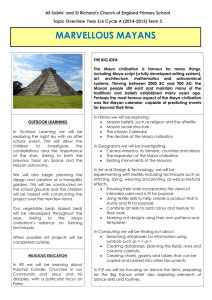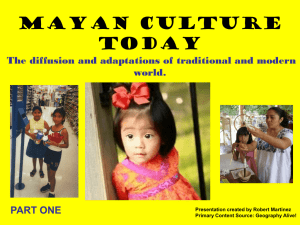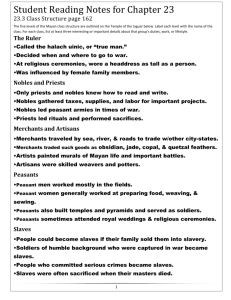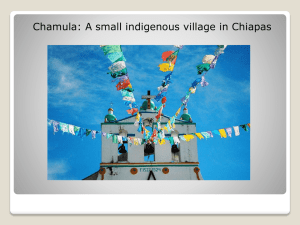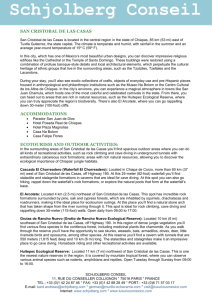Living Maya October 21-23, 2011 The culture of the highland Maya
advertisement
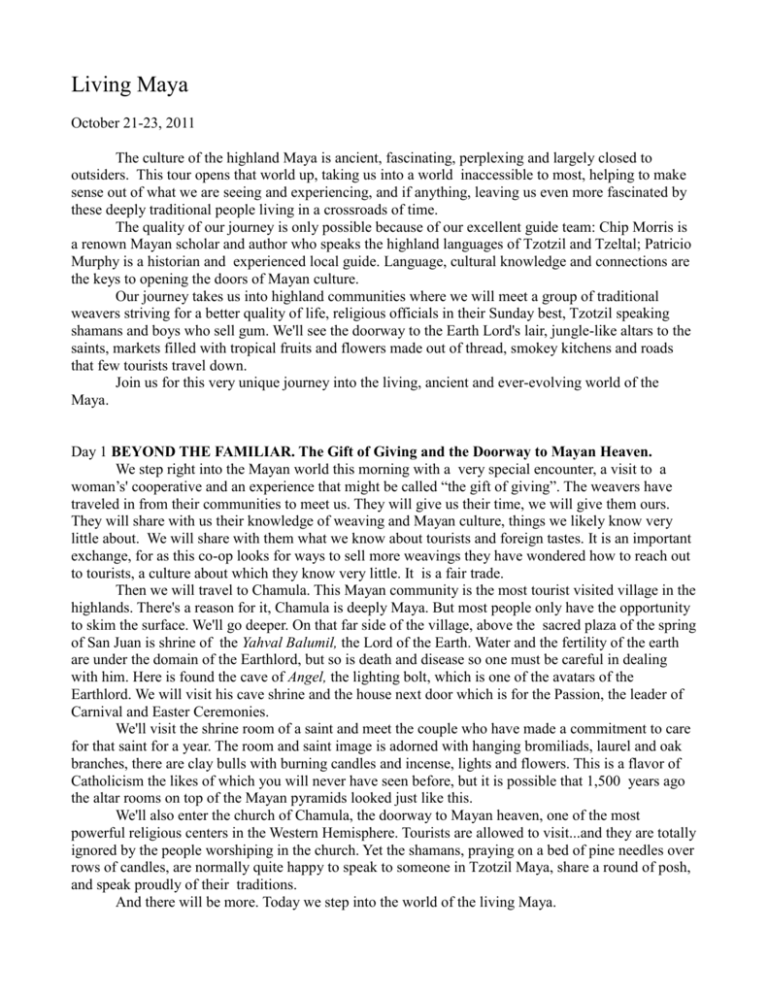
Living Maya October 21-23, 2011 The culture of the highland Maya is ancient, fascinating, perplexing and largely closed to outsiders. This tour opens that world up, taking us into a world inaccessible to most, helping to make sense out of what we are seeing and experiencing, and if anything, leaving us even more fascinated by these deeply traditional people living in a crossroads of time. The quality of our journey is only possible because of our excellent guide team: Chip Morris is a renown Mayan scholar and author who speaks the highland languages of Tzotzil and Tzeltal; Patricio Murphy is a historian and experienced local guide. Language, cultural knowledge and connections are the keys to opening the doors of Mayan culture. Our journey takes us into highland communities where we will meet a group of traditional weavers striving for a better quality of life, religious officials in their Sunday best, Tzotzil speaking shamans and boys who sell gum. We'll see the doorway to the Earth Lord's lair, jungle-like altars to the saints, markets filled with tropical fruits and flowers made out of thread, smokey kitchens and roads that few tourists travel down. Join us for this very unique journey into the living, ancient and ever-evolving world of the Maya. Day 1 BEYOND THE FAMILIAR. The Gift of Giving and the Doorway to Mayan Heaven. We step right into the Mayan world this morning with a very special encounter, a visit to a woman’s' cooperative and an experience that might be called “the gift of giving”. The weavers have traveled in from their communities to meet us. They will give us their time, we will give them ours. They will share with us their knowledge of weaving and Mayan culture, things we likely know very little about. We will share with them what we know about tourists and foreign tastes. It is an important exchange, for as this co-op looks for ways to sell more weavings they have wondered how to reach out to tourists, a culture about which they know very little. It is a fair trade. Then we will travel to Chamula. This Mayan community is the most tourist visited village in the highlands. There's a reason for it, Chamula is deeply Maya. But most people only have the opportunity to skim the surface. We'll go deeper. On that far side of the village, above the sacred plaza of the spring of San Juan is shrine of the Yahval Balumil, the Lord of the Earth. Water and the fertility of the earth are under the domain of the Earthlord, but so is death and disease so one must be careful in dealing with him. Here is found the cave of Angel, the lighting bolt, which is one of the avatars of the Earthlord. We will visit his cave shrine and the house next door which is for the Passion, the leader of Carnival and Easter Ceremonies. We'll visit the shrine room of a saint and meet the couple who have made a commitment to care for that saint for a year. The room and saint image is adorned with hanging bromiliads, laurel and oak branches, there are clay bulls with burning candles and incense, lights and flowers. This is a flavor of Catholicism the likes of which you will never have seen before, but it is possible that 1,500 years ago the altar rooms on top of the Mayan pyramids looked just like this. We'll also enter the church of Chamula, the doorway to Mayan heaven, one of the most powerful religious centers in the Western Hemisphere. Tourists are allowed to visit...and they are totally ignored by the people worshiping in the church. Yet the shamans, praying on a bed of pine needles over rows of candles, are normally quite happy to speak to someone in Tzotzil Maya, share a round of posh, and speak proudly of their traditions. And there will be more. Today we step into the world of the living Maya. Evening in San Cristobal. Day 2 OFF THE MAP. Today we go deeper. We'll travel a winding road through steep limestone mountains, into the land of corn farmers, weavers and slower ways of being. We travel beyond the guide books and tourist maps to a small village in the midst of a sacred Saturday tradition: shopping! Today, as it has been for centuries, is market day in Cancuc, a Mayan village perched on the edge of a mountain. The men and women are clothed in their unique traditional dress, whose designs would seem to come from a contemporary art museum, but are actually ancient. The man’s shirt is the same style as worn by Aztec military in the 15th Century. We will immerse ourselves in the market, observe and be observed, for we will be a bit like martians here. We'll snack our way through the vendors, trying steamed tamales, roasted corn, tropical fruits and perhaps pink cotton candy! In our travels we'll also stop at the house of a good friend for a hot drink and a moment to warm our hands and chat around the cooking fire in a traditional indigenous kitchen. She also happens to be one of the recognized great masters of Mexican folkart. And we'll peek into two churches, one with a wooden beamed roof and saints all about, another with no roof, no floor and no saints, but perhaps a horse or two grazing about. Evening in San Cristobal. Day 3 ONLY ON SUNDAY. Threaded Flowers and Mayan Priests. The market of Cancuc is remote and exotic. Yet perhaps the most colorful market in the highlands is in Zinacantan. But there is not a bit of food for sale in it. Rather it is filled with flowers in all tones...yet none of the flowers real, they are all of embroidered thread. This market, which happens only on Sundays, is for the women of Zinacantan by the women of Zinacantan. Here they come to buy and sell the gorgeous floral blouses and shawls that are the look de rigueur of the Zinacantecos. Also in Zinacantan, also only on Sunday, the Martomas, religious officials, elegantly decked out in long black woolen robes, wrapped in red turbans and wearing leather sandles right out of the Classic Era of the Maya, meet in the chapel of Esquipulas to change the coin necklaces on the Saints and to place new floral bouquets on the altar. The principal officials are seated at a long table in the center of the chapel, and save for the electronic bird chirps of the christmas lights that adorn the altar, it is like a scene from the ancient past. With our guide, we will respectfully step in for a visit. Then we visit San Andres Larraianzar, for another Sunday special. Here as well the Martomas, dressed in the most elegant of Mayan formal wear, meet in prayer while their wives sit in a circle around the image of San Andres and offer copal incense. Behind the church is the Sunday market where Maya from 7 different communities, each with a distinctive dress, meet to purchase highland vegetables and tropical fruits grown in nearby valleys. For lunch we'll head back to San Cristobal for a taste of quality and elegant cuisine before stepping into the 1930's and the era of explorers. Under the lead of the former director, we'll tour the lovely and musty halls of Na Bolom and learn about the Swiss-Danish adventurers who worked in the Lancandon jungles long before there were roads or cattle farming there, and what is being done to help preserve the culture of the last of the Lancandon Maya. Our day and tour concludes after this visit, but if we are providing lodging for you, your hotel this evening is included. Evening in San Cristobal. Trip Cost: REGULAR $540. DISCOUNT PRICE* $420 for summit participants Price includes transport in private van, lodging double occupancy** (single supplement $90), lunches daily, all scheduled event entry fees. Does not include alcoholic beverages, items of personal nature, tips to drivers, guides, maids, bell boys. *Discount price only available to registered ATTA summit participants. All others pay regular tour fee. **If you are providing your own lodging in San Cristobal please subtract $90 from the tour price. Tour Operator: Traditions Mexico Minimum adventurers: 4 Maximum adventurers: 12 Duration: 3 days/3 nights Difficulty: Easy Location: The deeper side of highland Chiapas. Departure point: San Cristobal Drop off point: San Cristobal
